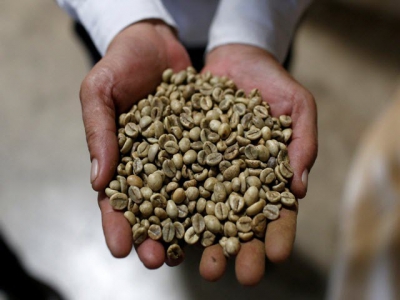Asia Coffee-Vietnam prices edge up on scarce supplies, stocks rise in Indonesia

HANOI/BANDAR LAMPUNG, Indonesia - Domestic coffee prices in Vietnam rose this week due to tight supplies, while inventories in Indonesia continued to build up, traders said on Thursday.
A worker shows coffee green beans at coffee company Simexco Dak Lak Limited in the town of Di An in Binh Duong province, Vietnam July 8, 2019. Picture taken July 8, 2019. Photo: Reuters
Farmers in the Central Highlands, Vietnam’s largest coffee-growing area, sold coffee at 32,000 dong ($1.38) per kg, higher than the 31,300-31,700 dong range a week ago.
“Farmers are reluctant to sell beans at this price, which is under the production cost of 33,000 dong, while some farmers have already sold pepper, planted alongside coffee trees, to cover their needs,” said a trader based in the region.
“Demand still exists but no one can buy at this price. It’s too high for us (traders) to make profit.”
Another trader in the region said he saw no factors for prices to rise at the moment and expected the prices to be around 30,600-32,000 dong per kg for the next month.
September robusta coffee settled down $9, or 1%, at $1,176 per tonne on Wednesday.
Traders in Vietnam offered 5% black and broken grade 2 robusta at $240 premium per tonne for the September contract, down from $250-$260 premiums last week.
Meanwhile, traders in Indonesia’s Lampung province on Sumatra island said premiums for robusta beans remain unchanged from last week despite higher supply, as overseas buyers continue to face tough competition from domestic buyers.
One trader said premiums for Sumatran robusta were at $340 to the September contract, while another trader offered premium at $370 to the August contract.
Volume of trade is starting to increase as Lampung starts its main coffee harvest, but Indonesia’s big instant coffee manufacturers are beating exporters with high pricing, one of the traders said.
“It is difficult for prices to come down still,” he added.
Có thể bạn quan tâm
 Long An asks for lifting of restrictions on sticky rice exports
Long An asks for lifting of restrictions on sticky rice exports Sticky rice is not a daily consumption item and so the ministry should not include sticky rice in the 400,000-tonne quota
 Inspection team set up to check rice volume stuck at ports
Inspection team set up to check rice volume stuck at ports An interdisciplinary inspection team led by the Ministry of Industry and Trade has been established to work with agencies to determine how much rice is stuck at
 Government chief requests surprise inspection of rice exports
Government chief requests surprise inspection of rice exports The request comes after the Government issued a document on April 20 which outlines PM Phuc’s opinion on recent rice export activities.
 Exports of rice to China skyrocket in Q1
Exports of rice to China skyrocket in Q1 The first quarter of the year saw the country export 162,000 tonnes of rice to China, accounting for 11% of the nation’s total export volume.
 Calls for shake-up in rice exporting
Calls for shake-up in rice exporting Rice export management is advised to make changes in order to ensure both food security and benefits for the business community.